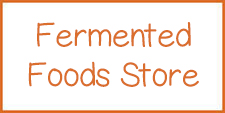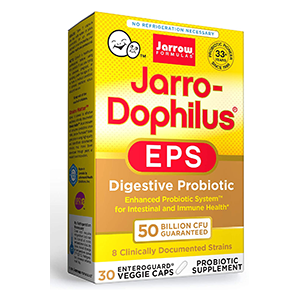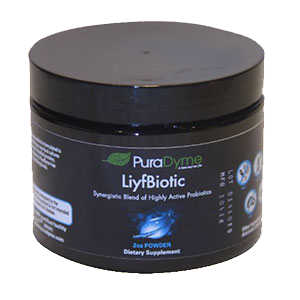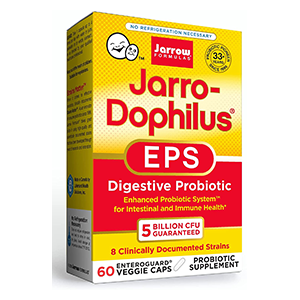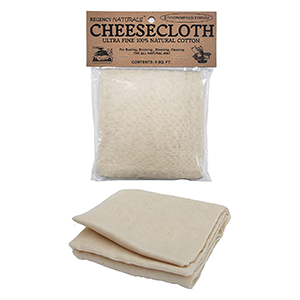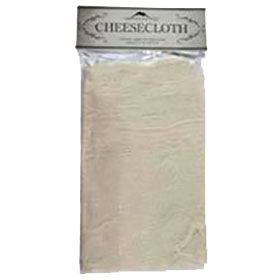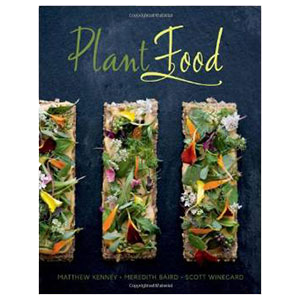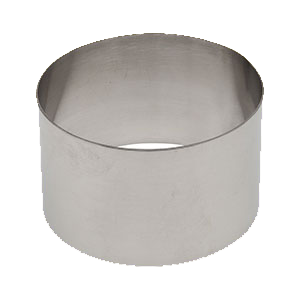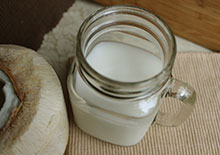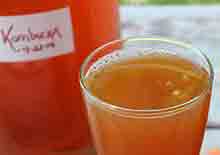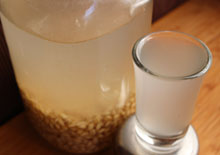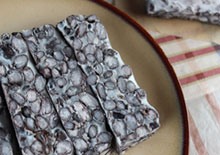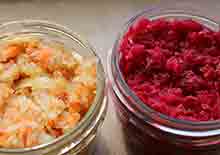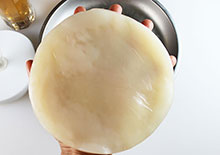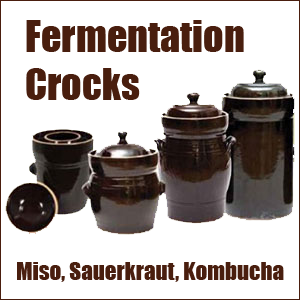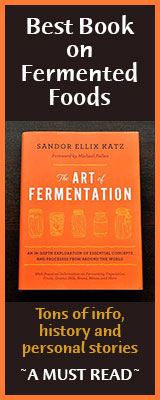- Home
- Fermented Food Recipes
- Seed Cheese Recipes
Seed Cheese Recipes, Cultured Raw Vegan Cheese

These are a few of our basic seed cheese recipes that we have evolved and customized over the years of fermented vegan cheese-making. We began experimenting with making seed cheese in the early 2,000's using one of the first original recipes created in the 1960's by living food enthusiast Ann Wigmore, founder of the Hippocrates Health Institute.
This version was a 4-12 hour ferment using mostly sunflower seeds, and sometimes pumpkin seeds, which produced a soft ricotta-style cheese spread.
Since then, however, we have moved beyond this traditionally cultured variety, adding other ingredients as well as allowing the cheese to "age" for at least 48 hours (or longer) to develop a firm sliceable texture with a sharp taste close to that of milk cheese.
Using different types of seeds, in addition to nut combinations, also produces unique and savory flavors comparable to cheddar, feta or gouda.
One of the leading authorities in the nut and seed cheese-making world is American celebrity chef and recipe book author Matthew Kenney, who specializes in plant-based cuisine. He has, over the years, experimented extensively with making gourmet vegan cheeses and was quoted in a published LA Weekly article stating that most cheeses he serves are aged "usually three to four weeks."
How to Make Vegan Cheese
These types of seed and nut cheeses are made much the same way you would make dairy cheese by separating the curds from the whey, using the same cheese-making methods that have been employed for centuries. When making seed cheese recipes, the blended seed and nut mixture is placed into a mesh nut milk bag and pressure is applied to remove the liquid whey from the protein and fat solids.
This is essentially the same process used to make dairy cheese, which is normally accomplished by packing the curds into a mold and applying a heavy weight on top of a "follower", a flat object that pushes the curds down evenly to release the whey liquid through tiny holes in the mold form.
Unlike dairy cheeses, these raw vegan versions are not made with seed or nut "milk" because they have a better flavor and texture when created with the whole seeds or nuts. The liquid whey is strained out of the blended mixture over a period of time to "age" it and intensify the sharpness of the cheese.
Seed and Nut Cheese Culturing Techniques
1) Using a Probiotic Culture
Homemade seed and nut cheeses are made using either a powdered probiotic supplement or culture starter to age the cheese, which also protects it from contamination. These powders contain Lactobacillus and Bifidobacterium strains like L. acidophilus and B. lactis as well as many others. The probiotics can be purchased as a bulk powder but usually come in capsule form which can be opened up into the cheese blend. To culture the cheese it takes 2 capsules (about 1/4t) per 2 cups of dry seeds or nuts.
(See the Shop Related Products section at the bottom of this page for a list of recommended probiotic supplements and cheese making supplies.)
2) Using a Mesh Bag or Jar
We have found that to make sliceable seed cheese recipes it is best to ferment the blended seed mixture in a fine mesh bag or nut milk bag. These are reusable bags, usually around $10, that will help to separate the curds from the whey and strain out most of the liquid, especially when pressure is applied.
For more about seed cheese visit our seed cheese page.
The average nut milk bag is made out of a nylon or hemp fabric and can be wash after use and will survive many years of seed cheese-making. They can also additionally be used to make nut milk or fresh juices.
For short ferments like our traditional seed cheese recipe, cream cheese recipe or parmesan recipe a one-quart mason jar with a non-metallic mesh sprouting lid works well. The jar is then turned upside down and tilted in a dish to drain out the liquid content.
3) Forming the Cheese
Seed and nut cheeses can be set in molds after fermentation time and refrigerated to create different shapes, logs or cheese wheels that can be later sliced. We have found that ring molds are best for achieving smooth rounded edges, but you can also use various bowls or containers that are either shallow, deep, round, square or oblong.
Some raw gourmet chefs, like Matthew Kenney, additionally put the form-molded cheese into a dehydrator to produce a thick rind on the outside. You can likewise cover your molded creations in pepper, various spices or a different assortment of chopped nuts and seeds.
How to Make Firm Sliceable Nut and Seed Cheese
We make dense sliceable cultured vegan cheeses by fitting a nut milk bag inside a colander and placing the blended mix inside the bag. After tightly securing the opening by spinning it several times and tying with a rubber band, we turn the cheese-filled bag with the rubber band pointed to the side before adding a weight.
The colander should sit inside a bowl to collect the liquid whey that is released over time, at least 2 days. It is also beneficial to put a jar lid on the bottom of the bowl to elevate the cheese so it is not sitting in liquid. Place a flat object on top to evenly distribute the weight.
To apply pressure, which will help squeeze out the moisture content, you will need to place a heavy weighted object on top. Glass jars filled with water work well for this purpose. Keep in mind, the more pressure you apply and the longer they ferment the firmer your cheeses will become.
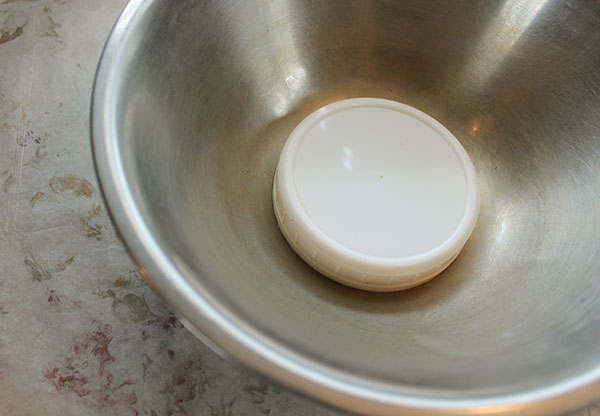 Bowl with a Lid on Bottom
Bowl with a Lid on Bottom Secure Tight with Rubber Band
Secure Tight with Rubber Band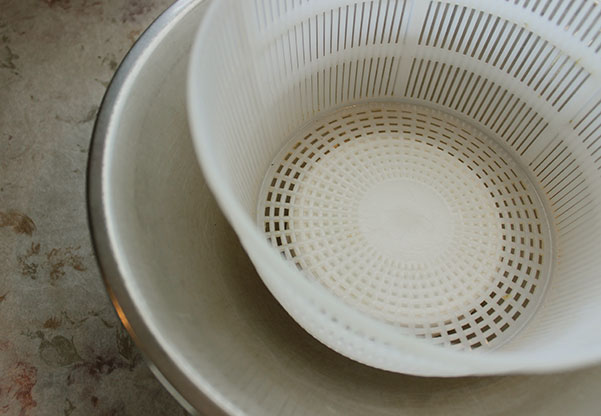 Place Colander on Top of Lid
Place Colander on Top of Lid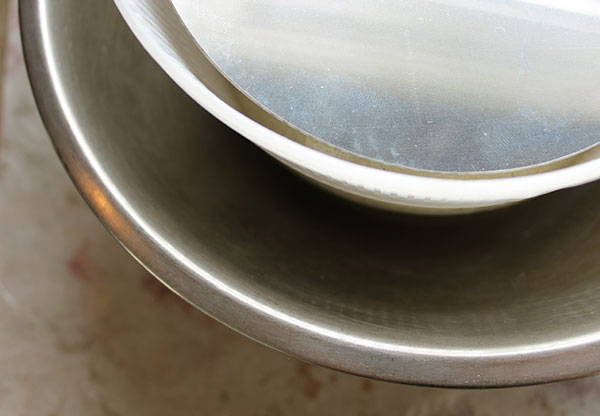 Place Flat Object on Top
Place Flat Object on Top Mesh Bag in Colander w Cheese
Mesh Bag in Colander w Cheese Place Weight or Jar Filled with Water
Place Weight or Jar Filled with WaterSeed Cheese Recipes
When making seed cheese, you can use different blends of nuts and seeds depending on your taste preference and/or unique health goals. Some seeds or nuts like sunflower, pumpkin and almond are less acidic than other varieties, like cashew or macadamia nut.
Sunflower Seed Cheese Recipe

This cheese can be made like a soft ricotta-type cheese or can also be cultured for 48 hours to produce a firm sliceable seed cheese. In this recipe, we give directions for both methods.
Instead of the probiotic culture, you can also use rejuvelac, which is the original way it was created by Ann Wigmore in the 60's.
Ingredients:
- 1C sunflower seeds
- 1C pumpkin seeds
- 1t sea salt
- pure water
- 1/4t probiotic powder (or the powder from 2 probiotic capsules)
- 1t paprika (for sliceable cheese)
Directions:
For Soft Spreadable Cheese
- Place pumpkin and sunflower seeds into a 1-quart jar.
- Add pure water, filling the jar.
- Soak overnight and strain out liquid.
- Rinse again with pure water.
- Blend in a high-speed blender with as little water as needed to thoroughly blend seeds, probiotic powder, sea salt and herbs.
- Pour into 1-quart jar and place a non-metallic mesh lid on top, cover with a clean cloth and place on a dish.
- Let it sit on your countertop or on a shelf for 4-12 hours or longer depending on the room temperature. Warmer temps help it to ferment faster.
- During the last half of the fermentation time, turn upside down tilted sideways into a bowl, and let the whey liquid drain out through the mesh lid.
You can usually tell when it's done when it has risen slightly in the
jar. If you ferment it too long it may ooze over the sides. Place a lid on the jar and store it in the fridge. This will stop the fermentation process.
For a Sliceable Cheese
- Place pumpkin and sunflower seeds into a 1-quart jar.
- Add pure water, filling the jar.
- Soak overnight and strain out liquid.
- Rinse again with pure water.
- Blend in a high-speed blender with as little water as needed to thoroughly blend seeds, probiotic powder, sea salt and herbs.
- Pour into a nut milk bag that is in a colander inside a bowl with a lid at the bottom to elevate it.
- Twist the mesh bag and secure with a rubber band.
- Place a heavy flat object or "follower" over the cheese ball and place heavy weight on top.
- Allow to culture for 48 hours below 75°F (24°C).
- Form the cheese using a ring mold.
- Add a layer of paprika powder to the outside of the molded cheese
Cream Cheese Seed Cheese Recipe

Ingredients:
- 1/2C sunflower seeds
- 1/2C cashews
- 1C irish moss gel
- 1/4t probiotic powder
- 1T dill weed
- 1t onion powder
- 1/2C water
- 1t sea salt
Directions:
- Soak your sunflower and cashews in water overnight using separate jars.
- Make irish moss gel following the directions on our irish moss gel recipe page.
- Strain the sunflower but do not strain cashews, use cashew water in blender.
- Place all ingredients into a high-speed blender and blend until smooth.
- Place in a jar with a mesh lid and allow to culture upside down for 4-8 hours.
- Place into a cheese mold and allow to set in the refrigerator.
- After this the cream cheese will gel and slide out of the mold when turned upside down.
- Place on a serving plate with crackers or in an airtight container for fridge storage.
Turmeric Vegan Parmesan Cheese Recipe
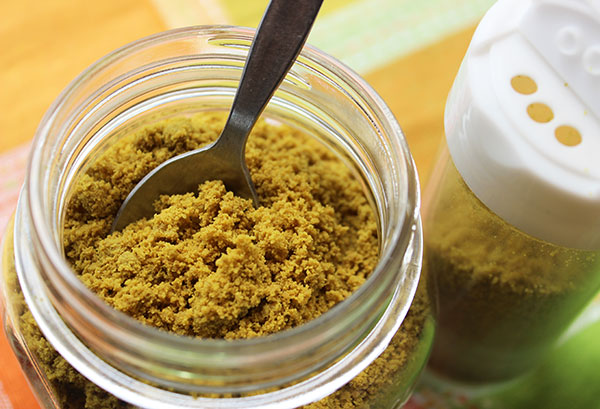
Ingredients:
- 1C sunflower seeds
- 1C pumpkin seeds
- 1/2C sesame seeds
- 1/4t probiotic powder
- 1t turmeric
- 1/8C lemon juice
- 1t sea salt
- pure water
Directions:
- Place seeds into a 1-quart jar.
- Add pure water, filling the jar.
- Soak overnight and strain out liquid.
- Rinse again in pure water.
- In a high-speed blender, blend all ingredients with just enough water to blend it smooth.
- Place in a jar with a mesh lid and allow to culture upside down for 4 hours.
- Place on a dehydrator non-stick sheet with screen underneath.
- With a rubber spatula layout cheese into a squared shape. The thinner it is the faster it will dehydrate.
- After 4 hours flip over onto the screen and break up into pieces.
- Leave it in the dehydrator on med-low for 24 hours or until
dry.
- Powder the parmesan pieces in a blender to desired texture.
- Store in a glass jar or cheese shaker in a cool dry place.
(Visit our original vegan parmesan cheese recipe using just sunflower seeds.)
Buying Your Nuts and Seeds
It is always good to use high quality organic non-GMO raw seeds and nuts. This means that if you tried to sprout a sunflower seed, for example, it would actually grow another sunflower plant. This assures it has not been genetically modified or heat treated.
Most all seeds will sprout when giving the water necessary to do so, but other more fattier nuts, like cashews or macadamia, are more easily germinated when inside their shell. Some people also sprout their seeds before making seed cheese, but it is not required.
Can Seed Cheese Go Bad?
The probiotic lactic acid bacteria in the ferment helps to protect the seed cheese recipe from contamination or decomposition. But, just like dairy cheese, it can grow other forms of mold over time if not properly stored or fermented at inappropriate temperatures exceeding 75°F (24°C).
It is also important to use clean nuts and seeds that have been thoroughly rinsed in pure water.
Seed cheese should have a slightly soured fermented scent that smells
like aged cheese. It should be discarded if it has an extremely strong
off-putting odor. Keep in mind that it is normal for the whey liquid to be a dark color and smell somewhat like sulfur. We usually dispose of the whey, although some people like to use it in other recipes.
Raw Vegan Nut and Seed Cheese Benefits
Raw nut and seed cheese recipes are great non-dairy cholesterol-free alternatives made from simple whole foods. They are better than many commercial non-dairy almond, rice or soy cheeses because they are not overly processed or heated, nor do they contain refined oils or fats, preservatives, starches or stabilizers common in packaged products.
Fermenting foods, like nuts, seeds and beans, removes toxic digestive
inhibitors and further breaks them down into easily digested amino acids
and other energizing compounds.
Generally, nuts and seeds are harder to assimilate in their natural state because they have phytates that inhibit the absorption of various minerals and proteins. Soaking and rinsing them helps to eliminate some of these digestive inhibitors, but the process of fermentation also greatly improves phytate removal and considerably increases nutritional value.
The culturing technique not only creates a delicious cheese-like flavor but also produces enzymes and beneficial microflora that help to improve digestion and balance intestinal microbiota. Unlike dairy, which tends to create a lot of mucus build-up and sinus conditions, raw vegan cheeses tend to do quite the opposite, providing more of a laxative-like effect that helps to promote regular bowel movements and keeps the colon free of undigested waste material.
How to Use
Seed cheese recipes can be enjoyed with raw dehydrated crackers, onion bread, added to salads, raw soups, pizza or wrapped in nori with vegetables.
Visit some of our other raw vegan recipes for foods that go well with seed and nut cheeses or recipes that use them.
See our fermented food recipes page for our top 7 recipes in the links below.
Precautions:
It is, of course, important to avoid seed or nut cheeses if you have severe allergic reactions to different varieties of nuts or seeds. It is also important to consider avoiding food ferments if you have severe allergies to molds.
Shop Related Products (About Affiliates & Amazon Associate Paid Links)
Affiliate Disclaimer: This section contains affiliate product links. If you make a purchase through our recommended links, we receive a small commission at no additional cost to you. Thanks for the support.
